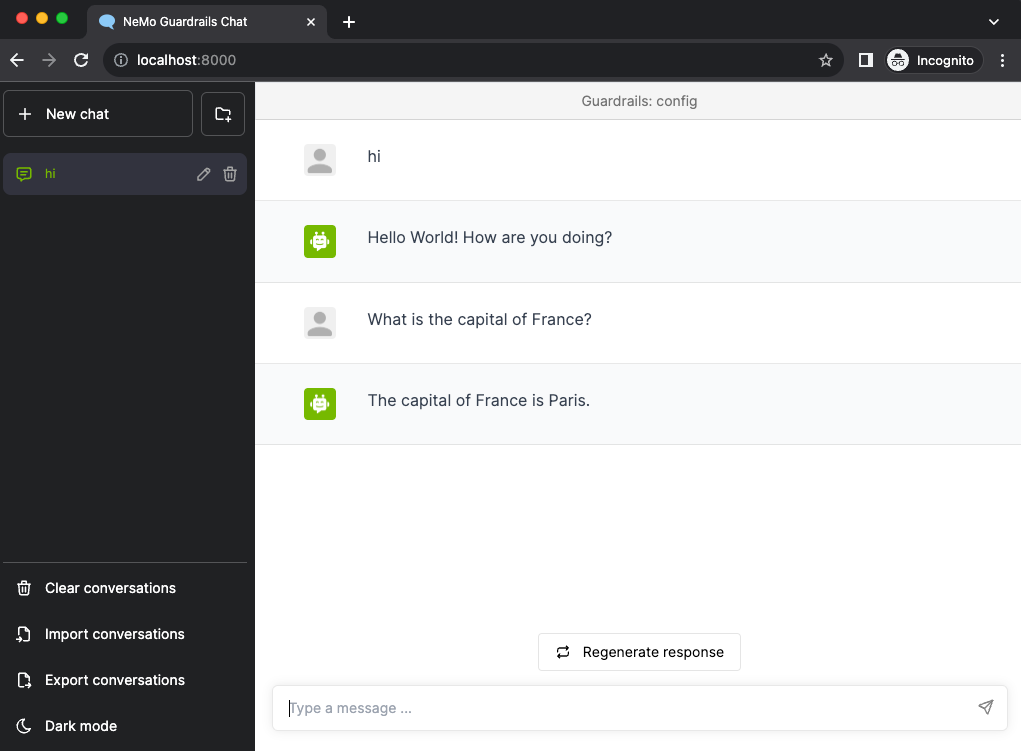Hello World#
This guide shows you how to create a “Hello World” guardrails configuration that controls the greeting behavior. Before you begin, make sure you have installed NeMo Guardrails.
Prerequisites#
This “Hello World” guardrails configuration uses the OpenAI gpt-3.5-turbo-instruct model.
Install the
openaipackage:
pip install openai
Set the
OPENAI_API_KEYenvironment variable:
export OPENAI_API_KEY=$OPENAI_API_KEY # Replace with your own key
If you’re running this inside a notebook, patch the AsyncIO loop.
import nest_asyncio
nest_asyncio.apply()
Step 1: create a new guardrails configuration#
Every guardrails configuration must be stored in a folder. The standard folder structure is as follows:
.
├── config
│ ├── actions.py
│ ├── config.py
│ ├── config.yml
│ ├── rails.co
│ ├── ...
See the Configuration Guide for information about the contents of these files.
Create a folder, such as config, for your configuration:
mkdir config
Create a config.yml file with the following content:
models:
- type: main
engine: openai
model: gpt-3.5-turbo-instruct
The models key in the config.yml file configures the LLM model. For a complete list of supported LLM models, see Supported LLM Models.
Step 2: load the guardrails configuration#
To load a guardrails configuration from a path, you must create a RailsConfig instance using the from_path method in your Python code:
from nemoguardrails import RailsConfig
config = RailsConfig.from_path("./config")
Step 3: use the guardrails configuration#
Use this empty configuration by creating an LLMRails instance and using the generate_async method in your Python code:
from nemoguardrails import LLMRails
rails = LLMRails(config)
response = rails.generate(messages=[{
"role": "user",
"content": "Hello!"
}])
print(response)
{'role': 'assistant', 'content': "Hello! It's nice to meet you. My name is Assistant. How can I help you today?"}
The format for the input messages array as well as the response follow the OpenAI API format.
Step 4: add your first guardrail#
To control the greeting response, define the user and bot messages, and the flow that connects the two together. See Core Colang Concepts for definitions of messages and flows.
Define the
greetinguser message by creating a config/rails.co file with the following content:
define user express greeting
"Hello"
"Hi"
"Wassup?"
Add a greeting flow that instructs the bot to respond back with “Hello World!” and ask how they are doing by adding the following content to the rails.co file:
define flow greeting
user express greeting
bot express greeting
bot ask how are you
Define the messages for the response by adding the following content to the rails.co file:
define bot express greeting
"Hello World!"
define bot ask how are you
"How are you doing?"
Reload the config and test it:
config = RailsConfig.from_path("./config")
rails = LLMRails(config)
response = rails.generate(messages=[{
"role": "user",
"content": "Hello!"
}])
print(response["content"])
Hello World!
How are you doing?
Congratulations! You’ve just created you first guardrails configuration!
Other queries#
What happens if you ask another question, such as “What is the capital of France?”:
response = rails.generate(messages=[{
"role": "user",
"content": "What is the capital of France?"
}])
print(response["content"])
The capital of France is Paris.
For any other input that is not a greeting, the LLM generates the response as usual. This is because the rail that we have defined is only concerned with how to respond to a greeting.
CLI Chat#
You can also test this configuration in interactive mode using the NeMo Guardrails CLI Chat command:
$ nemoguardrails chat
Without any additional parameters, the CLI chat loads the configuration from the config.yml file in the config folder in the current directory.
Sample session#
$ nemoguardrails chat
Starting the chat (Press Ctrl+C to quit) ...
> Hello there!
Hello World!
How are you doing?
> What is the capital of France?
The capital of france is Paris.
> And how many people live there?
According to the latest estimates, the population of Paris is around 2.2 million people.
Server and Chat UI#
You can also test a guardrails configuration using the NeMo Guardrails server and the Chat UI.
To start the server:
$ nemoguardrails server --config=.
INFO: Started server process [27509]
INFO: Waiting for application startup.
INFO: Application startup complete.
INFO: Uvicorn running on http://0.0.0.0:8000 (Press CTRL+C to quit)
The Chat UI interface is now available at http://localhost:8000:

Next#
The next guide, Core Colang Concepts, explains the Colang concepts messages and flows.